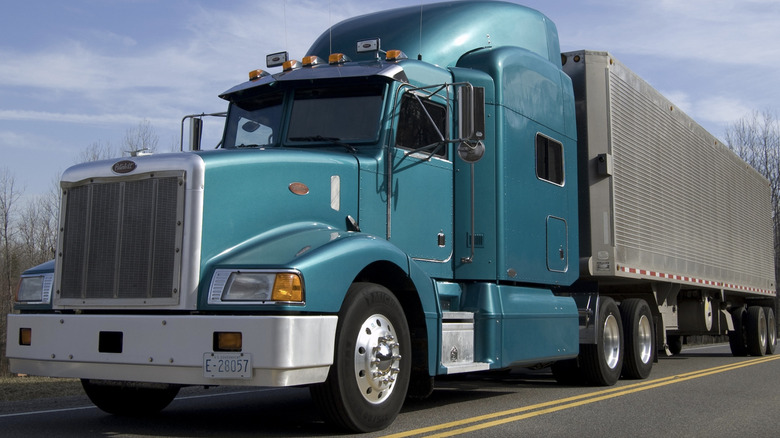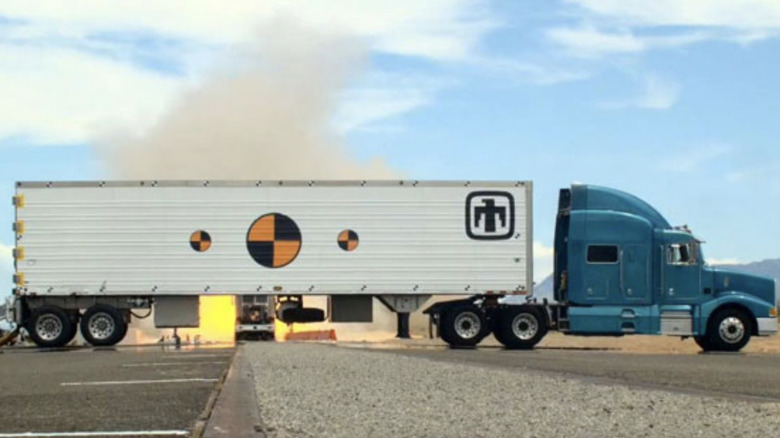What Are The US Government's Ghost Trucks And What Do They Look Like?
Transporting sensitive material such as weapons or classified science gear is no easy task, and when it's a country as expansive as the United States, the stakes couldn't be higher. But you can't just put out a job listing for a truck service to move a shipment of artillery across states. Everything needs to be meticulously planned and executed. When it comes to nuclear weapons, there is little scope for errors. For such projects, the US government relies on "ghost trucks," a fleet of fleet of highly specialized trucks that haul nuclear weapons across different facilities in the country.
Officially known as Safeguard Transporters (SGT), these trucks, these massive and unremarkable-looking trucks, have been deployed for transporting nuclear devices for five decades. The Office of Secure Transportation (OST), which runs under the aegis of the National Energy Department's National Security Administration, is responsible for this secretive movement. These vehicles are used for moving materials such as "nuclear weapons or components, enriched uranium, or plutonium"
Unmarked vehicles with armed federal agents move close by, while these highly modified secure tractor-trailers are operated by agents who are cleared to use lethal force in case of any emergency. These trucks are especially configured inside-out to "deter and delay adversaries," and they are specially engineered to avoid fire hazards and other mechanical risks in case an accident or hostile event transpires. Multi-layer reinforcements and specialized structural linings on the side walls, and a fortified floor are put in place to protect the cargo inside.
Built to survive the worst
Officially, the SGT trucks are described as a "technologically advanced vehicle that enhances safety and security for special nuclear material cargoes." These vehicles are structurally designed to survive "very severe" highway accidents, such as impact and fire hazards. These trucks are usually triple-axle truck tractors hooked to a two-axle semi-trailer. The OST, which manages the convoy of these ghost trucks, has headquarters in Albuquerque and two other command centers in Amarillo, Texas, and Ridge, Tennessee.
There have been some worries regarding the safety standards and management responsible for operating these normal-looking 18-wheel trucks, but the officials claim to have maintained a clean record, so far. "For more than 40 years — even after driving the equivalent distance of a trip to Mars and back — no cargo has ever been damaged in transit," the agency told a news outlet.
The robust construction of these trucks includes walls that release immobilizing foam, an integrated electrical shock delivery system, and axles that self-explode if a hostile element tries to tow them away by force. "These trucks will kill you," says an expert. These vehicles are fireproof to such an extent that their cargo remains undamaged even when fully engulfed in flames. Sandia, which is contracted by the Department of Energy's National Nuclear Security Administration, revealed a new line-up of Armored Tractors (ATs) in 2000. These modified Peterbilt trucks were lighter, designed to offer more comfort, and customized to "blend in with the rest of the 18-wheelers on the highways" to avoid detection.
A closely-guarded secret, managed with caution
For a long time, these trucks remained a secret, which is not surprising given the kind of materials they haul. "The terror threat is significant. If you are in one of the communities along the route, you have something to worry about," an Energy Department official was quoted as saying by The Los Angeles Times. In 2009, a non-profit named Friends of the Earth filed a Freedom of Information Act request, forcing the energy department to release color photos of these specialized trucks. "It is believed that these are the first nuclear bomb truck photos released by the Department of Energy in recent years," it said.
The agency's Transportation and Emergency Control Center maintains a round-the-clock, throughout the year. Aside from ensuring a real-time link, the agency also maintains an emergency line for these trucks as a contingency plan. There are special facilities along the routes designated for these vehicles, in case a weather anomaly necessitates a pit stop or route change. Historically, the National Nuclear Security Administration (NNSA) has been responsible for moving nuclear materials, going as far back as 1947.
Initially, the Transportation and Safeguards Division (TSD) was responsible for handling these operations, but following the FY2000 National Defense Authorization Act, TSD was replaced by the Office of Transportation Safeguards (OTS). People hired to drive these trucks are usually ex-soldiers who have been deployed overseas and former special operations commandos. These agents subsequently receive a long training that spans nearly two years, arming them with skills to thwart on-road terrorist attacks and theft attempts.

